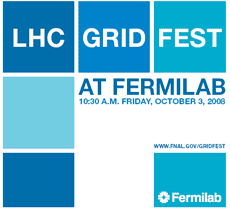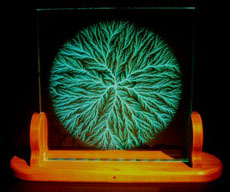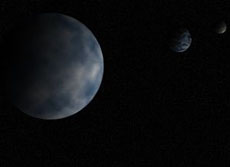|
Friday, Sept. 26
8:30 a.m. - 3 p.m.
Pixels08 Conference - One West
9 a.m.
Seminar - West Wing, WH 10NW
Title: A Highly Scalable Grid Enabled Distributed Disk Storage System
12 p.m.
Gallery Lecture Series - Curia II
Speakers: Lori Napoleon and Ed Wesly (Artists)
Title: Optics and Artists: Intersections of Art and Science
3:30 p.m.
DIRECTOR'S COFFEE BREAK - 2nd Flr X-Over
4 p.m.
Joint Experimental-Theoretical Physics Seminar - One West
Speaker: Benjamin Grinstein, University of California, San Diego
Title: Lepton Flavor Violation
Monday, Sept. 29
2:30 p.m.
Particle Astrophysics Seminar - Curia II
Speaker: Massimo Ricotti, University of Maryland
Title: Fossils of the First Galaxies in the Local Group and the Role
of Reionization Feedback on Suppressing the Formation of
Dwarf Galaxies
3:30 p.m.
DIRECTOR'S COFFEE BREAK - 2nd Flr X-Over
4 p.m.
All Experimenters' Meeting - Curia II
Special Topics: Tevatron Lattice and Measurements;
CALICE Scintillator-ECAL Beam Test
Click here for NALCAL,
a weekly calendar with links to additional information. |
Friday, Sept. 26
- Smart cuisine: Italian vegetable soup
- Teriyaki chicken
- Southern fried chicken
- Smart cuisine: Mediterranean baked tilapia
- Eggplant parmesan panini
- Assorted Sliced pizza
- Assorted sub sandwich
Wilson Hall Cafe Menu |
|
Wednesday, Oct. 1
Lunch
- Cider roasted pork loin
- Sage muffins/warm apple salsa
- Pumpkin cheesecake
Thursday, Oct. 2
Dinner
- Frisée & apple salad w/dried cherries and walnuts
- Paella
- Pineapple flan
Chez Leon Menu
Call x4598 to make your reservation. |
|
|
CDF, DZero reach 5 inverse femtobarns of luminosity
Fermilab's Tevatron collider experiments, CDF and DZero, both reached 5 inverse femtobarns of luminosity this week. The experiments have been taking data since March 2001. DZero reached its integrated luminosity record on Sunday, Sept. 23. CDF reached its 5 inverse femtobarns on Thursday.
Physicists count the number of collisions produced in the Tevatron in units of inverse femtobarns.
Three years ago, on June 24, 2005, Fermilab celebrated 1 inverse femtobarn for CDF and DZero. Read more about that milestone here.
|
Fermilab will host Grid Fest on Friday, Oct. 3

Grid Fest will take place Oct. 3
The six experiments at the Large Hadron Collider will produce 15 million gigabytes of data every year, enough information to create a 13-mile-high stack of CDs. Fermilab will join CERN on Friday, Oct. 3, at 10:30 a.m. to launch the World wide LHC Computing Grid, the system that will distribute this data to more than 7,000 scientists across the globe.
On Oct. 3, live connections between Fermilab and CERN will demonstrate the extraordinary role of grid computing. Experts will highlight the successes and challenges of the grid, and its applications to other sciences such as medicine, climate studies, bioinformatics, nanotechnology, geography and education.
Information about the event is available at http://www.fnal.gov/gridfest/. More information about U.S. participation in the LHC and its experiments is available at http://www.uslhc.us.
|
Exhibit features art from science, light

This Lichtenberg figure, created by Tevatron operations specialist Todd Johnson, is currently on display as part of "Intersections: the Art and Science of Light" exhibit in the Fermilab Art Gallery.
A new exhibit in Fermilab’s Art Gallery highlights the connections between art and science.
“Intersections: the Art and Science of Light,” features works of holographic and multimedia art by Tevatron operations specialist Todd Johnson, photographer and holographer and former Fermilab researcher Ed Wesly (who worked on bubble chamber experiment E-632), and holography and light artist Lori Napoleon.
The current exhibit can ultimately be traced back to the Fermilab bubble chamber experiment in the mid-80's and the part holography played in the experiment.
In this neutrino experiment, holograms were used in tandem with more conventional photographs to capture neutrino interactions. In these high-energy interactions, the short-lived particles that were produced would decay at times on the order of 10-13 seconds. Holography was able to provide a picture of the interaction at a higher resolution over a long depth of field than the existing photographic recording technique.
In that exhibit, all three artists present a visual history and documentation of the bubble chamber experiment. They also display other individual works.
The artists come from diverse backgrounds - engineering, education, laser optics and fine arts. It was Fermilab, the space where these interests overlap in science-inspired art, that made it possible for them to meet, collaborate and celebrate how physics and art can be mutually appreciated.
The exhibit will run through Nov. 10. A Gallery lecture will take place today from 12-1 p.m. in Curia II. An artists’ reception will take place from 5-7 p.m. tonight on the second-floor Art Gallery. Visit the Art Gallery
Web site
for more information. |
Galaxy flow hints at huge masses over cosmic horizon
From New Scientist, Sept. 25, 2008
Hundreds of clusters of galaxies are streaming en masse towards a region at the edge of the visible universe. The discovery has taken astronomers completely by surprise because the movement is independent of the universe's expansion.
A team led by Alexander Kashlinsky of NASA's Goddard Space Flight Center in Greenbelt, Maryland, stumbled upon the flow while studying how galaxy clusters affect the photons of the cosmic microwave background (CMB), the radiation left over from the big bang.
Kashlinsky has dubbed the stream "dark flow" to align it with the other as yet-unexplained characteristics of the universe, dark matter and dark energy.
The discovery arose because the movement of the clusters changed the frequency of CMB photons, creating a Doppler effect, the characteristic signature of movement. "To our great surprise, we found a very weak but identifiable [Doppler] signal, significantly above the noise," Kashlinsky told New Scientist.
According to the observations, the clusters are all moving towards a patch of sky that lies between the constellations Vela and Centaurus. Some are speeding away at about 1000 kilometres per second, and it seems likely the flow continues to the edge of the visible universe.
"This motion extends all the way to at least a billion light years, and perhaps longer," says Kashlinsky. "If it already goes so far, it would be very puzzling if it just stopped."
Read more
|
|
|
Grids meet aliens and androids

"To boldly go where no man has gone before..."
Image courtesy of Patrick Wormsley, sxc.hu
A Pangalactic Workshop on BOINC is the sort of place you might expect to meet people in Star Trek suits.
In fact, at the fourth edition of this workshop, held at the INRIA institute in Grenoble 10-12 September, the talk was not about space travel, but about volunteer computing. ("Pangalactic" is a tongue-in-cheek reference to SETI@home, or Search for Extra-Terrestrial Intelligence. It harnesses personal computers to sift through radio wave data from outer space-the most visible of volunteer computing projects since it was launched in 1999.)
SETI@home spawned BOINC, the Berkeley Open Interface for Network Computing, which is now used as a general-purpose platform for volunteer computing by over 50 projects, running on about a million volunteer computers, with an aggregate processing power of over 1 petaflop as of January. While SETI@home remains popular, the workshop showcased many other projects, and was a chance for project developers and distributed-computing experts to discuss new directions for
volunteer computing.
One of the most promising directions is the convergence of volunteer and grid computing. For example, Einstein@home uses volunteer computers to analyze date from gravitational wave detectors, and it now runs over 10% of its analysis Germany's D-Grid, using BOINC to distribute the work. (See previous iSGTW story, Hello, Einstein residence . Why yes, he's home!)
Read more
-Francois Grey, for iSGTW
|
Sunday's "60 Minutes" will feature the LHC
A segment on the LHC is scheduled to appear in the 41st season premier of "60 Minutes" this Sunday, Sept. 28. The title of the segment is "The Collider."
Featured in the segment are four U.S. scientists: Bob Stanek from Argonne, Monica Dunford from the University of Chicago, Steven Goldfarb from the University of Michigan and Steve Nahn from MIT, plus James Gillies and Austin Ball from CERN.
"60 Minutes" airs on CBS at 8 p.m. CDT.
|
New Travel Office form effective Oct. 1
Effective Oct. 1, the Travel Office and Accounting Department will
discontinue the use of the four-part Travel Authorization/ Expense Voucher
(TA/EV). For trips approved on or after Oct. 1, employees should use the
new TA/EV Excel spreadsheet for travel authorization, travel advance and
travel settlement. Trips approved prior to Oct. 1 on the old four-part form
should be completed on that form.
The new form has a procedure section that outlines the travel approval,
advance and reimbursement process. The form is available on the Accounting and Travel Office Web sites.
|
dCache seminar at 9 a.m. today in WH 10NW
A seminar titled "dCache: A Highly Scalable Grid Enabled Distributed Disk Storage System" will take place today in the Wilson Hall West Wing meeting room, 10NW at 9 a.m. today.
The dCache product has served as a main analysis disk data storage system for the CDF experiment at Fermilab and is the chosen storage system for a number of Tier 1 and 2 LHC sites, including Fermilab US-CMS Tier 1 system. The seminar will cover the dCache project status, new features in the upcoming dCache 1.8 as well as a dCache project roadmap for the next year. A Q&A session will follow the presentations.
For more information, visit the Web site or e-mail Timur Perelmutov. For more information about dCache, visit http://www.dcache.org. Video and audio connection options are available for remote participants. Technical videoconference questions can be directed to Sheila Cisko at scisko@fnal.gov and videoconf@fnal.gov.
|
|
Have a safe day!
Save the date: labwide party on Oct. 17
To say thank you and to celebrate Fermilab's achievements of the last year,
the Fermi Research Alliance will host a labwide party in the Wilson Hall
atrium on Friday, Oct. 17, from 3:30 to 6:30 p.m. The party will feature
international snacks, beverages, music and door prizes. All Fermilab
employees, users, contractors and DOE employees are invited.
Kyuki-Do begins Sept. 29
Kyuki-Do, a Korean martial art similar to Taekwondo, can help teach you balance, power, grace and self confidence. Classes begin Sept. 29 and are held for six weeks on Mondays and Wednesdays from 5 - 6 p.m. at the Recreation Facility in the Village. You need to register through the Recreation Office and have a Recreation Facility membership.
English country dancing Sunday
English country dancing will meet Sunday, Sept. 28, in Kuhn Barn. Newcomers are always welcome and all dances are fully taught. This session will focus on dances of Jane Austen's times. A potluck supper will follow at around 5:30 p.m. for those who wish to stay. At the group's next meeting, on Sunday, Oct. 26, we will have live music with Old Fezziwig's Band. For more information, please contact folkdance@fnal.gov or call (630) 584-0825 or (630) 840-8194.
Classifieds
Find new classified ads on Fermilab Today.
Additional Activities
|
|